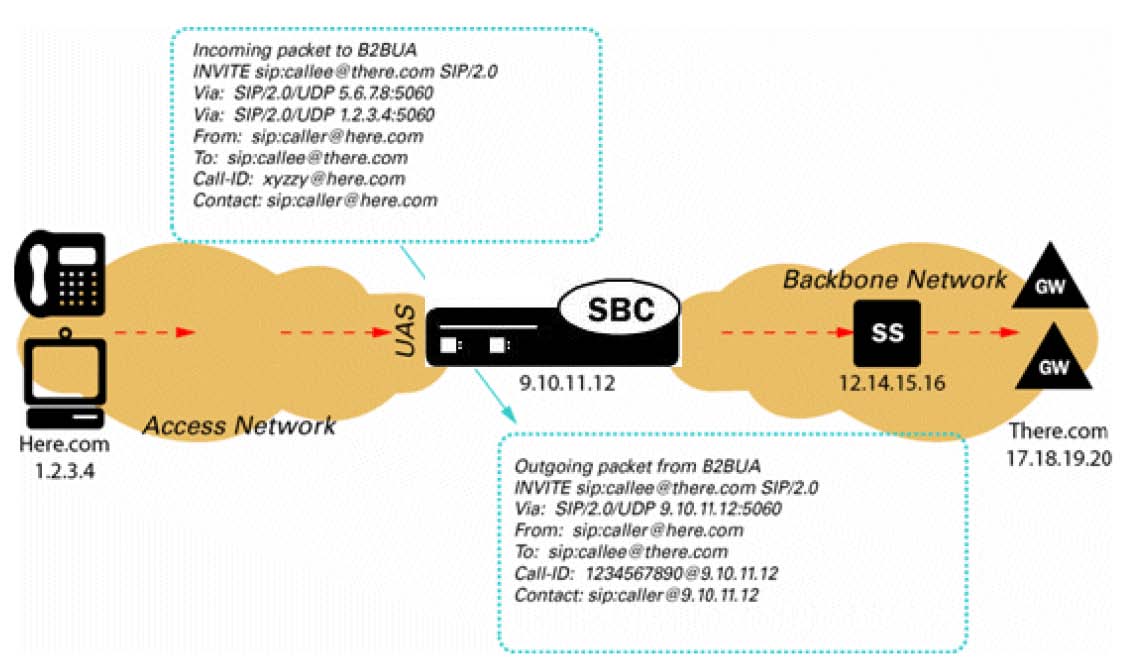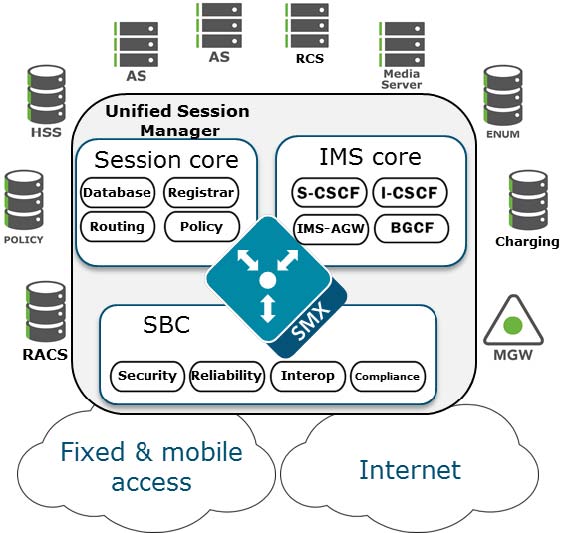Recommended Deployment Topologies
This section outlines the planning process for a secure installation and describes several recommended deployment topologies for the system.
Session Border Controller
- Peering - In a peering
model the SBC is contacted by a SIP server to relay endpoint signaling
information. The SIP server may be a PBX, registrar, proxy, SBC, or other
device. The IP of the device is usually trusted and pre-provisioned in the SBC
as an endpoint (session agent) that will be relaying calls. Since the remote
endpoint is already known, Access Control Lists (ACL) and Call Admission
Controls (CAC) can be pre-provisioned for the appropriate level of protection
or service level assurance.

- Access - In an access
model the SBC is contacted by a SIP endpoint to relay endpoint signaling
information. The IP address of the endpoint is usually not known, so trust
should be established through behavior such as establishment of a successful
registration. Once the endpoint becomes trusted, dynamic Access Control Lists
(ACL) and Call Admission Controls (CAC) can be applied. Monitoring of
potentially abusive behaviors provides a mechanism to “demote” or blacklist
endpoints.

- Hybrid - A hybrid model combines both Peering and Access topologies into a single configuration. This is a fairly common model, where remote users use a registrar server in the core network, but their calls are forwarded to a service provider on one of the peer connections.
Unified Session Manager
The Unified Session Manager (USM) provides edge security for an IMS
network, and should be positioned at access borders to integrate "traditional"
SBC functionality with the core IMS session control functions. It provides a
user registrar, local subscriber tables and Call Session Control Function
components such as Proxy CSCF, Interrogating CSCF, Session CSCF, IMS Access
Gateway, Emergency CSCF and Breakout Gateway Control Function.

Core Session Manager
Session Router
The Core Session Manager, which should never be positioned at a
network edge, is used as a core session controller between multiple network
types. It supports SIP in IMS and non-IMS environments, application servers,
media servers, gateways, etc. It can be deployed in a distributed, virtualized
model on COTS server hardware. The CSM can be used for session routing,
interoperability assurance, CAC, and subscriber database integration through
HSS, ENUM, or local subscriber table databases.

The Session Router is a “pure” SIP session router that can be
positioned in either a core network or at network borders. When installed at a
border, the same SBC protections used in peering and access models can apply.
In the network core, the emphasis is on routing and interoperability.
Enterprise Communications Broker
The Enterprise Communications Broker (ECB) should only be deployed
within an enterprise core network, and not on the edge. Instead of perimeter
security, the ECB is oriented towards functions such as dial plan management,
centralized session, routing, CAC, load balancing, and interworking.
Realm Design Considerations
- A mix of user endpoints, gateways, or peer trunks on the untrusted network
- Varying capabilities or incompatibilities of user agents
- Impacts of blocking traffic to one group of users vs. another (i.e. trust low or medium)
- Service level agreements (SLA) that require Call Admission Controls (CAC)
- Separate endpoints into realms based on trust level (high, medium, low) and that the response to detected abuse is appropriate for them (no action, demotion or blocking)
- Create multiple realms for endpoints based on the type of device – a user endpoint, a gateway, or a peer - since they will have very different considerations for SIP Header Manipulation, trust, signaling thresholds, endpoints behind NAT, and CAC.
- Consider increasing the deny-period from 30 seconds to something longer depending on how much abuse it is believed will be received from a public network and what type of delay users may tolerate.
- Set restricted-latching to sdp so only media received from the IP and port negotiated in signaling will be allowed.
- Pay close attention to the media management settings required for the endpoints and traffic flows (see the mm- parameters on the realm). If one way-audio is experienced this is one place to start investigating.